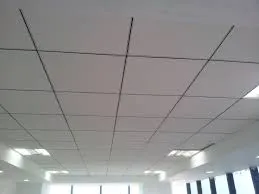10 月 . 19, 2024 23:15 Back to list
mineral fiber ceiling specification
Understanding Mineral Fiber Ceiling Specifications
Mineral fiber ceilings have become a popular choice in both commercial and residential settings due to their excellent acoustic properties, thermal insulation capabilities, and aesthetic appeal. This article aims to provide an in-depth understanding of mineral fiber ceiling specifications, highlighting their composition, benefits, installation, and maintenance considerations.
What is Mineral Fiber Ceiling?
Mineral fiber ceilings, often referred to as acoustic tiles or ceiling boards, are primarily composed of natural minerals such as gypsum, fiberglass, and other organic materials. This composition allows these ceilings to offer unique sound absorption qualities, making them ideal for environments where noise reduction is a priority. They are usually available in various textures and designs, able to blend seamlessly with diverse architectural styles.
Composition and Characteristics
The core of mineral fiber ceilings typically consists of a combination of cellulose fibers and mineral-based materials. The cellulose fibers provide structural integrity, while the mineral components contribute to fire resistance and moisture control. Manufacturers often incorporate additives to enhance characteristics like mold resistance, sound absorption (measured in Noise Reduction Coefficient - NRC), and sag resistance.
Key specifications to look for include
- NRC Rating As mentioned, this rating gives insight into the ceiling's ability to absorb sound. A higher NRC rating indicates better sound attenuation, essential in spaces like offices, schools, and theaters. - Fire Resistance Class Mineral fiber ceilings are often classified according to their fire resistance, typically rated as Class A (best performance) or Class B, based on their ability to resist flames and limit smoke development. - Humidity Resistance This specification measures the ceiling's ability to withstand high humidity levels without sagging or deteriorating. Look for ceilings with a high humidity resistance rating, especially in areas prone to moisture, like kitchens and bathrooms.
Benefits of Mineral Fiber Ceilings
1. Acoustic Control The primary advantage of mineral fiber ceilings is their sound absorption properties. They significantly reduce noise levels, enhancing comfort and productivity in busy environments.
mineral fiber ceiling specification

2. Fire Safety With inherent fire-resistant characteristics, mineral fiber ceilings contribute to safety in building designs and adhere to strict building codes. This is particularly important in commercial settings.
3. Energy Efficiency These ceilings can help improve energy efficiency by providing insulation. They contribute to maintaining a stable indoor temperature, thereby reducing heating and cooling costs.
4. Aesthetic Versatility Available in various finishes and patterns, mineral fiber ceilings can complement any interior design scheme. They can be easily painted, allowing for further customization.
Installation Considerations
The installation process for mineral fiber ceilings is relatively straightforward, often involving either a suspended grid system or direct application to the roof deck. Here are some factors to keep in mind
- Substrates Ensure that the underlying structure where the ceiling will be installed is dry, clean, and free of any contaminants. Proper surface preparation is vital for a durable finish. - Grid System For suspended ceilings, the grid system must be installed correctly to support the mineral fiber tiles securely. Follow manufacturer guidelines for spacing and weight limits. - Sealing and Finishing It's essential to seal any edges or joints appropriately to prevent moisture ingress, especially in humid environments.
Maintenance
Maintaining mineral fiber ceilings involves regular cleaning and periodic inspections to ensure they remain in optimal condition. Dust and dirt can accumulate over time, affecting both appearance and performance. Gentle vacuuming or damp cleaning with a mild detergent can restore their aesthetic appeal.
Conclusion
Mineral fiber ceilings offer a blend of functionality, safety, and aesthetic versatility, making them a prime choice for various applications. When considering mineral fiber ceilings for your space, it’s essential to understand their specifications fully, from NRC ratings to fire resistance and humidity levels. By aligning these specifications with your project needs, you can create a comfortable, efficient, and visually appealing environment that meets contemporary standards.
-
Revolutionizing Interior Design with Ceilings t grid Suspended SystemNewsOct.29,2024
-
Revolutionizing Ceiling Design with ceiling access panel with Gypsum Tile WaterproofNewsOct.29,2024
-
Revolutionizing Interior Design with PVC Gypsum Ceiling: A Comprehensive GuideNewsOct.29,2024
-
Elevating Interior Design with High quality Mineral Fiber Ceiling TilesNewsOct.29,2024
-
Revolutionizing Interior Design with PVC Gypsum Ceiling: A Comprehensive GuideNewsOct.29,2024
-
Elevating Interior Design with High-Quality Mineral Fiber Ceiling Tiles: A Comprehensive GuideNewsOct.29,2024







